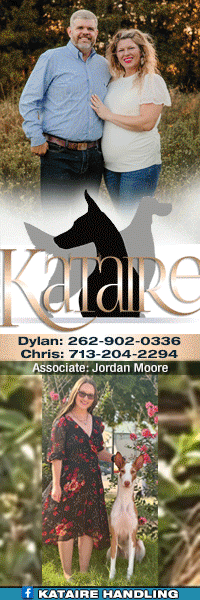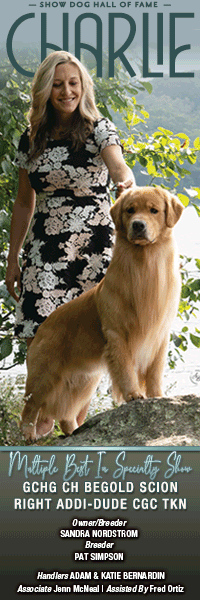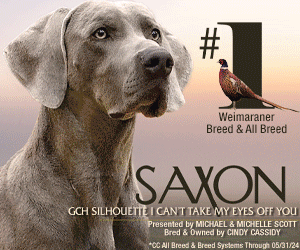From The CC Vault: That Pick of the Litter Puppy
By William J. Given
 At shows and at club meetings, I have heard novice breeders ask seasoned and highly successful breeders, “What is the best age to select your pick of the litter puppy?” On one hand, a puppy just minutes old and still wet gives you the best representation of genetic potential, but the most accurate answer to the query has to be, “When he is eleven months, three weeks and six days old.”
At shows and at club meetings, I have heard novice breeders ask seasoned and highly successful breeders, “What is the best age to select your pick of the litter puppy?” On one hand, a puppy just minutes old and still wet gives you the best representation of genetic potential, but the most accurate answer to the query has to be, “When he is eleven months, three weeks and six days old.”
The question that always seems to follow is, “How soon can one be absolutely certain that the pick of the litter puppy will finish?” The answer to that question is quite simple, “After he has both majors and secures a win that gives him the required 15 points necessary to earn his championship.”
Fortune telling could possibly provide us with the answer to our queries if we could go back in time to consult the sibyl of the Oracle at Delphi. I simply refuse to put any faith in a Ouija board, crystal ball or a Gypsy paw reader when it comes to discovering just how the pick of the litter puppy will turn out. Like most breeders, I have learned that it is virtually impossible to know exactly what a puppy will look like at maturity. Puppies can change so much and so quickly. What a puppy looks like next week may not be what he will look like next month, and next year is sheer folly.
To further illustrate my point, the dog which you whole-heartedly believe will do very well at the show this coming weekend may suddenly develop an allergy and blow coat. If you go to the show, he may only have two chances of winning his class, slim and none. However, at the other end of the spectrum, your pick of the litter puppy may finish from the puppy class and take wins and placements in the Group ring before he is a year old. He just might come to possess every physical attribute you desire but lack the temperament and showmanship to ever be a success in the show ring. Between the two ends of the spectrum there are quite literally thousands of possibilities.
Everyone who has ever bred a litter are well aware of the possibilities and will readily acknowledge the pitfalls of selecting their pick of the litter. Some of us have even attempted to impress our colleagues by embellishing on the difficulties experienced in selecting our pick of the litter. That makes it reasonable to ask, “Why do we spend so much time and energy trying to select that pick of the litter puppy?”
We pick because we must. It is a task forced upon us by our passion for the game and the drive to achieve the goals of our breeding programs. Some of us enjoy the challenge of making the pick, a few of us think we are relatively good at it and have been very successful, but not many of us have complete confidence in our prognostications.
Not all puppies in our litters will mature to be superior sires or prove themselves in the whelping box to be reliable brood bitches. The goal of a breeding program is to produce the highest quality show dogs possible and the object of the breeding is to retain the best for future efforts.
Without a large home or large kennel, sufficient acreage and unlimited capital resources, you just cannot keep them all. At some point we must take an honest look at the litter as a whole, and each puppy separately and decide (some would use the term guess) which one or two to keep. The remainder of the litter can be placed in pet homes at fair and reasonable prices.
The time frame from birth to a few hours old may very well be the best time to make your pick. At this age, the puppies are quite simply the product of genetics and gestation. There are three things that make your pick of the litter ‘the pick’. They are: his pedigree, the way he looks (and when you look at him now, you really can see his raw genetic potential), and what you hope he will be in the future. And, you can reasonably base that hope on his genetics. Now, the naysayers who would denounce and decry this method will tout the fact that over the next eight weeks your pick puppy will change so much based on the environmental factors that he will be subjected to…and they are correct. But ask yourself, “Will not all of the puppies in the litter be subjected to the exact same environmental stresses, and, will not all of the puppies respond to those factors in a similar fashion based on the strength of their genetic constitution?”
There are some highly successful breeders who would suggest that the time between three and four weeks of age allows for a much more reliable assessment of potential. It is because at this age they are moving around the litter box and are truly beginning to look like dogs. At this time you will also have a better idea as to which puppies are stronger, faster and more adventurous. Many breeders would argue that it would be just as unwise to make your decision now as at birth because you have five more weeks before the puppies will be fully weaned, and the real problem is that from birth to eight weeks of age the puppies will change so much.
Every time you look at the puppies in your litter, you could somewhat reasonably expect to have a new favorite. Maybe the best method would be to keep a running tally for the full 57 days. Each and every day you take some quality time to evaluate and rank, in order, the puppies in the litter. At the end of eight weeks, the puppy with the most number 1s gets declared your keeper.
Attempting to determine your pick of the litter with fault judging is, I believe, an unwise practice. However, it can be a useful technique in deciding which pups are no longer under consideration and can eventually be placed in good, loving pet homes. Knowing which faults are common in your breed, and certainly those which are prevalent in your line, will hopefully help prevent you from suffering the effect of kennel blindness and allow you to take notice of any fault should one appear. Remember, in certain breeds, puppies and young dogs may show faults that are known to be self-correcting with maturity. Nevertheless, there is always the possibility that these faults will remain or even worsen with age.
There is always a chance that when the puppies are eight weeks old, you will have absolutely no idea whatsoever as to which puppy is your pick of the litter. Mother Nature can be fickle. There is always the distinct possibility that all of the puppies will be good but possess no qualities that will allow them to excel in the show ring.
Why Eight Weeks Matters
Most highly successful breeders have a waiting list of puppy purchasers before they even conduct the breeding. Often experienced breeders will also begin advertising, by word of mouth and in breed specific or all-breed show dog publications, as soon as they have an idea of how many puppies their bitch will deliver. Why do they do this? To some degree, it is to find show homes for the puppies determined to have show potential but are not the keepers. It is primarily because of the responsibility they have to their pet quality puppies. Those buyers want to purchase their puppy when he is fat, cute and cuddly. At eight weeks, he is weaned and ready to leave his dam and his littermates.
Those puppies in the litter with show potential can, of course, be held onto longer. Those buyers have a deeper desire. The lack of coat and furnishing, or the awkwardness and lankiness of a 12- or 16-week-old puppy will in no way dissuade them. If they are experienced in the breed, have done their homework and know the power of his pedigree, they will see him for his true potential.
Other Things To Consider
No mature dog will be as dark as when he was an eight-week-old puppy. If you are evaluating the puppies in your litter and one is as light in color as the Standard allows, then he is absolutely not your keeper as he will only get lighter. Just as dark markings tend to lose their depth of color, they also tend to spread and dominate the lighter markings as the dog matures and the coat grows. Also, understand that while shoulders may tighten and fronts sometimes straighten, his cow hocks will not correct. A back that is too long will not shorten with maturity.
Heads can and often do change greatly with maturity. The heavy or course head of a puppy, surprisingly, often becomes more refined. It is also possible that an overly refined head on a puppy may become correct as he ages. I have heard, but have never been in the position to personally confirm, that heads sometimes lengthen. However, this is not a self-correction that I would spend time hoping for this change. Additionally, his eyes will not grow darker with age. However, it is possible the dog’s coat may fade with time to match sufficiently so as to allow you to get away with it in the ring. Unfortunately, the set-on of the ears will not correct. Whether the ears are set too high or too low, too close or too far apart, trying to force the ears into the correct position will not work; it has been tried, over and over again. Accept the fact that he is not your keeper.
I am in no way suggesting that you ignore the potential of each puppy as soon as a fault appears. Nor am I implying that in the end you may have no puppy at all. You want to keep your best puppy, he is your pick of the litter. It is important, however, that your pick of the litter be healthy, and mentally and structurally sound appropriate for his age. Remember the power your pedigree carries with it incredible potential.
Of course, there is always the possibility that you will have been very fortunate with the selection of the sire and you have two or even more outstanding puppies. If you possess the resources, you do not even have to decide which of those exceptional puppies are the pick of the litter. When they are six months of age, you can enter them in the puppy classes and let the judges make the decision for you.
Short URL: https://caninechronicle.com/?p=256149
Comments are closed












